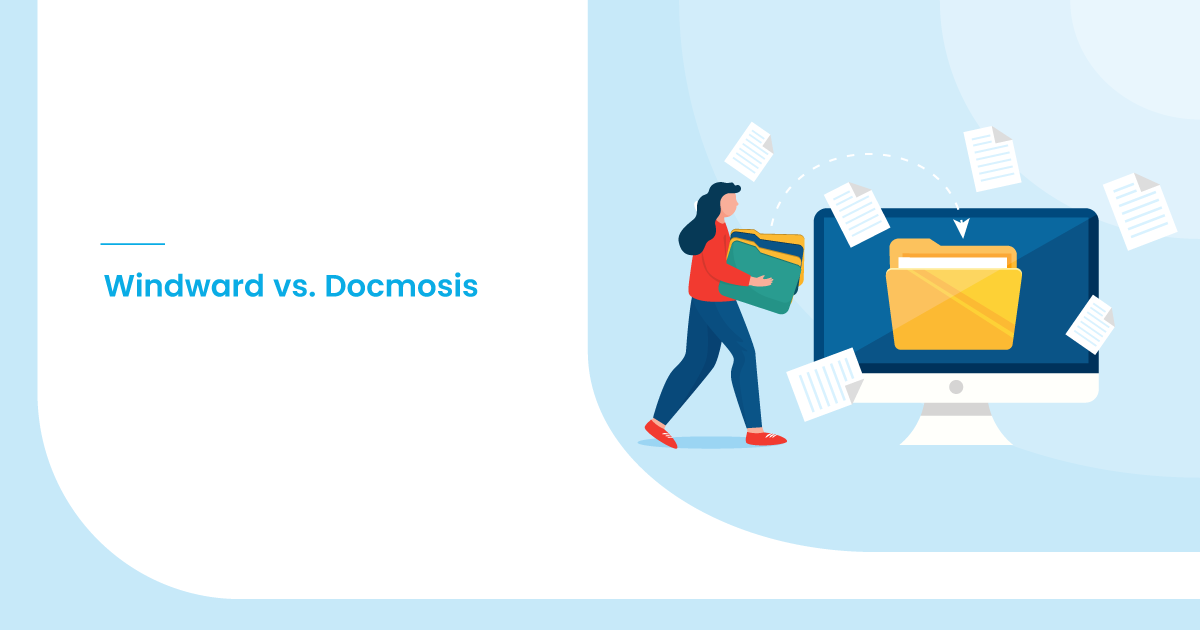Are you on the lookout for a new document automation solution?
If so, you might have heard that Windward and Docmosis are the two biggest names providing ultimate document generation solutions across verticals. While they have the same target audience, they are pretty much different when it comes to comparing their software capabilities.
On the one hand, where Docmosis offers an intuitive graphical interface to create templates, on the other, Windward liberates you to create stunning documents just the way you visualize. Well, this might be a small difference, but there are some key differences that you shouldn’t miss if you are deciding between the two.
Windward vs. Docmosis: A Detailed Comparison Report
1. Applications
Docmosis lets you create and design templates on MS Word without any plug-ins. The prime benefit of using Docmosis, I must say! However, it would help if you had LibreOffice to have Docmosis functional on your system, which in turn is complex to install and get through.
When it comes to Windward, it operates seamlessly with your MS Word. In fact, you can utilize all the benefits of working in a familiar environment with added advantages from the tool. Besides, you can work with Windward on MS Excel and MS PowerPoint, which is not possible with Docmosis. If you are someone who only requires working in MS Word and is sure you won’t need Excel or PowerPoint someday in the future, Docmosis is a good shot. But if you doubt expanding your document generation to Excel or PowerPoint, think thrice before giving the go-ahead to Docmosis. If you ask me, Windward would be a better choice in that case.
2. Templates
Creating and designing templates is fun with Docmosis and Windward. While Docmosis has got amazing templating features, Windward makes it easier to develop smart document layouts with its drag-and-drop functionality.
To fetch data when your document template is run, Docmosis requires you to put placeholders, i.e., data fields. It follows a specific format, and any placeholder not following the format won’t return data. Also, it doesn’t support drag-and-drop functionality. So, you need to put them manually in each template. When you are dealing with a basic document template with only 2-3 variable fields to return, the process seems pretty straightforward. But when you have a complex document to work on, the process is quite tricky.
On the contrary, Windward comes with Office AddIns, data structures, tag tree, drag-and-drop functionality, and more to create even the most complicated document in a snap.
3. Queries
As you might know, Windward is a “no-code behind” document automation tool. Meaning, you don’t require to pen down codes for building documents. Simply drag and drop the field you want to insert, and it will generate code on its own. Moreover, it has got a Query Wizard that eases your template creation process.
When it comes to Docmosis, it doesn’t have any Query Wizard. Thus, crafting templates is a developer-only task. In addition to this, it requires you to use third-party tools for writing queries. So, in this aspect, Windward is a clear winner!
4. Programming
Your document automation tool must be such that your technical, as well as non-technical staff, can work with it effortlessly. If it requires programming experts to design documents, all your efforts of researching and investing in a tool go in vain.
While Docmosis do need a programmer to create complex documents, it is an excellent choice for businesses that deal with simple document templates. But if the requirement is complex, Windward is a better alternative.
Windward vs. Docmosis At A Glance
| Features |  |
 |
|---|---|---|
| Multiple Datasources | It can also process multiple datasources simultaneously | It has the ability to mix data from multiple datasources |
| Macros | You can create custom macros as and when required in your template | It comes with 50 in-built standard functions but does not support custom Macros |
| Rendering Barcodes | Windward renders barcodes as fonts, which may not be as effective as images | Docmosis renders barcodes as images, which is far better than its competitors |
| Validation, Error & Warning Handling | It takes care of each aspect to ensure you get the document as desired | It lists errors and warnings on test generation but does not validate templates |
| Output Format | It supports all the output formats you want including printer |
DOCX HTML RTF |
| Drag & Drop Doclets | Supports pretty well | Doesn’t support |
| Pros & Cons |
|
|
Wrapping Up
Docmosis comes with some significant benefits like its ability to mix data from multiple datasources, in-built macros, and rendered barcodes. These are something that any organization with basic document generation needs would love to have. But as it works with LibreOffice, it supports only what LibreOffice offers.
While it supports different output formats, it seems to be limited as compared to Windward. Again, Windward’s ability to generate code on its own and drag-and-drop functionality is something you might be attracted to. Furthermore, it comes power-packed with Office AddIns, Tag Tree, Query Wizard, and more to make document generation easier.
So, be wise to opt for any of these based on your business needs. In case you want to explore more about these products, we have an in-depth review of Windward and Docmosis. Navigate through them and make the most informed decision.
Need Any Technology Assistance? Call Pursho @ 0731-6725516




